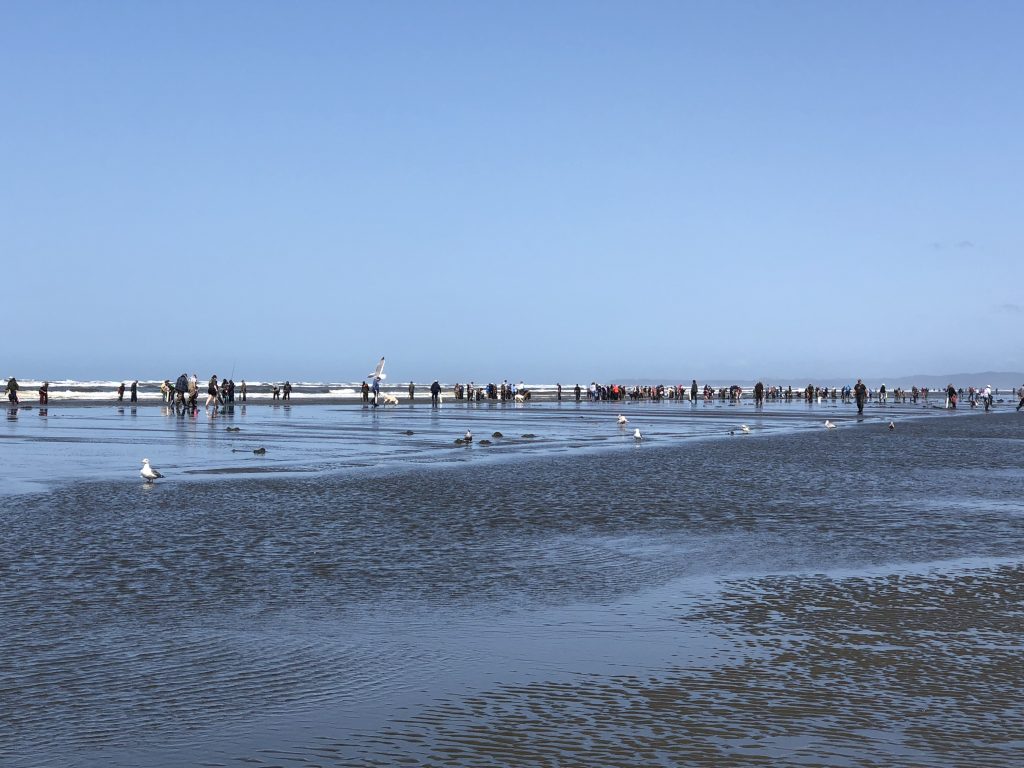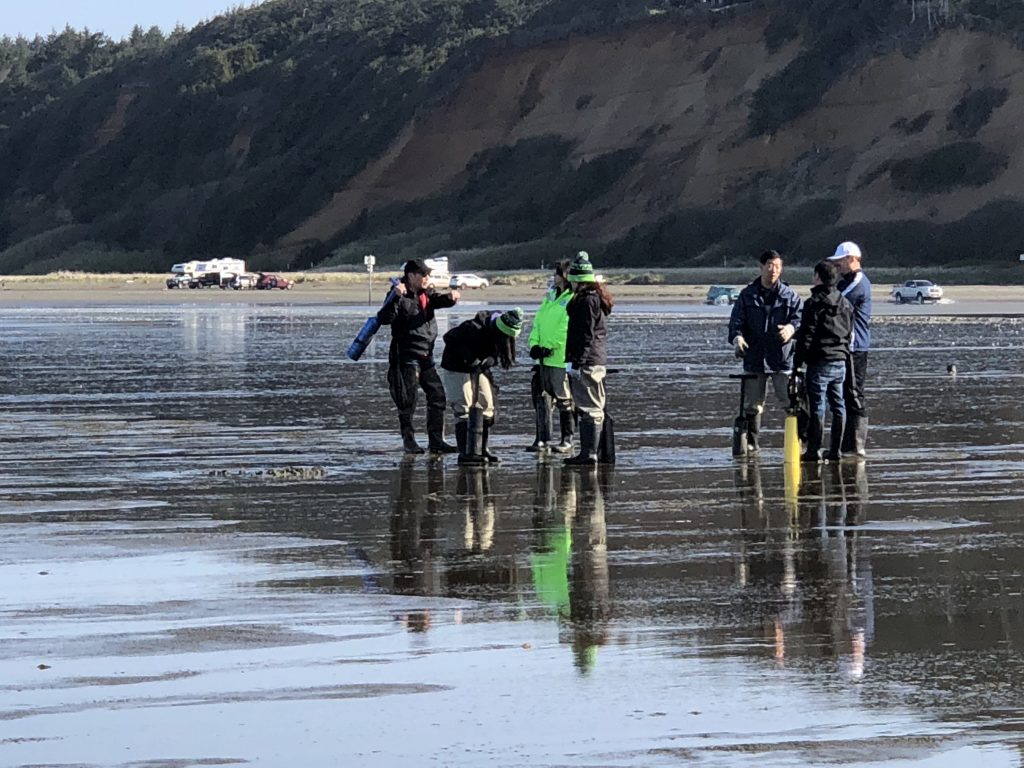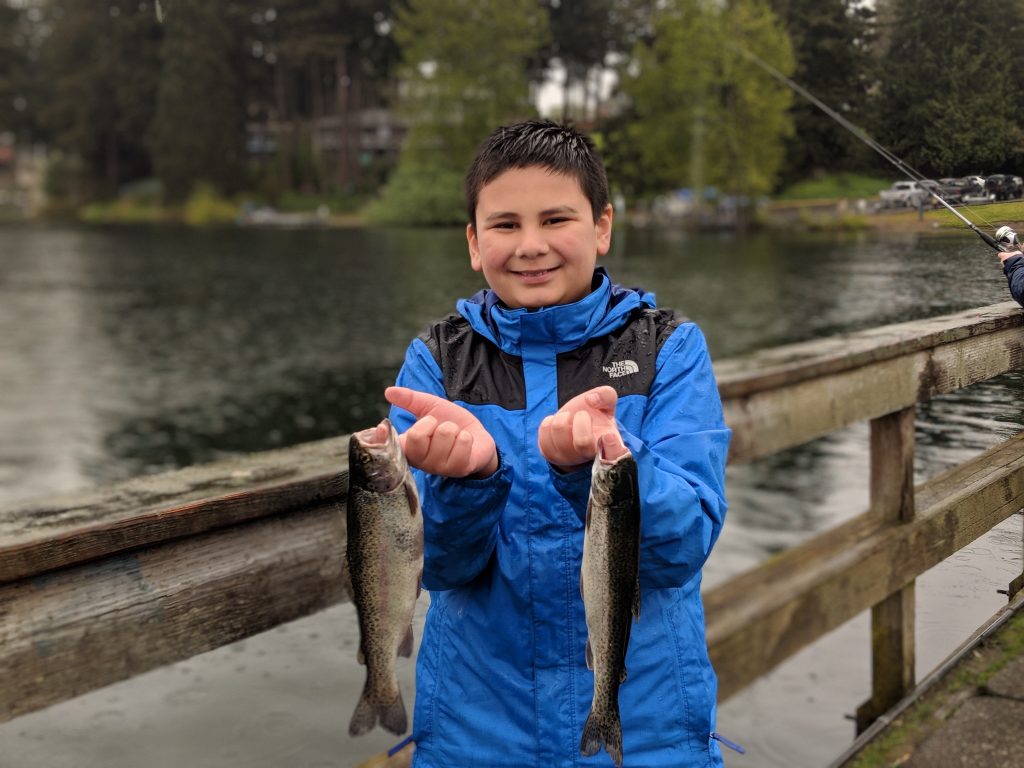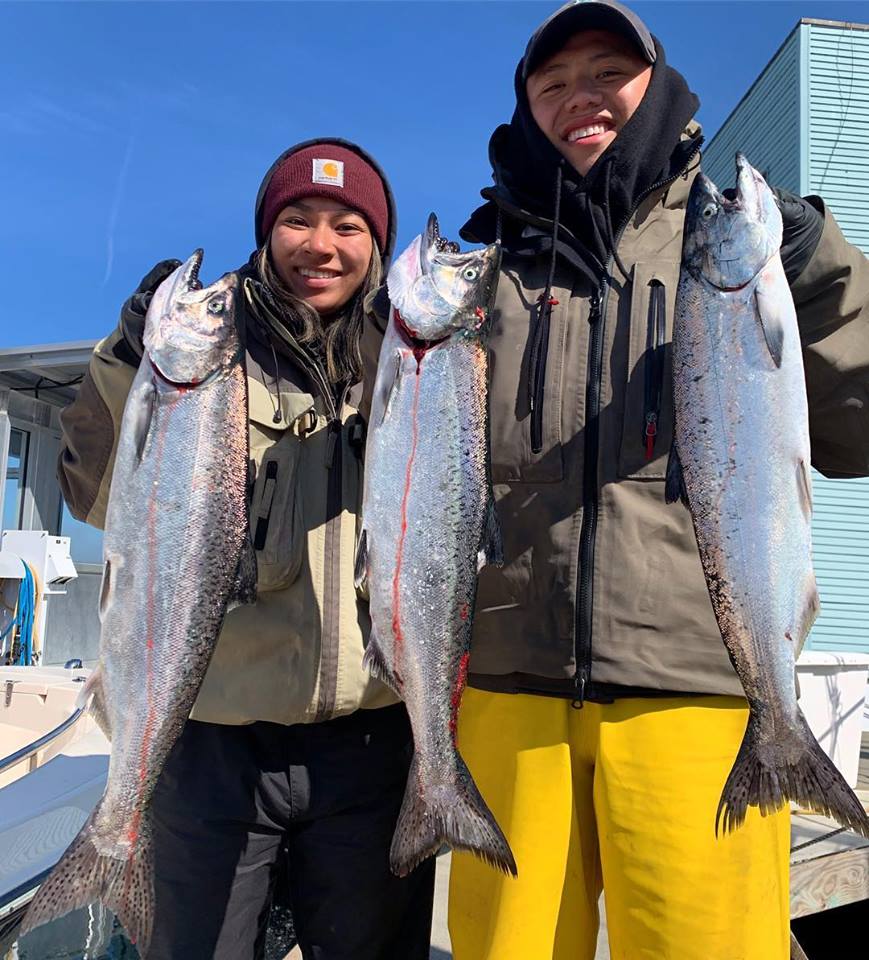Great signs ahead for coastal razor clam digs as season may be on pace for record turnout with acres of clams Leave a reply

By Mark Yuasa
We’ve almost reached the halfway mark of the 2019-2020 coastal razor clam digging season and it has been a slam dunk of optimism with the possibility of many brighter times ahead.
“The biggest story of this razor clam season is the sheer lack of bad weather and that has really helped,” said Dan Ayres, the head WDFW coastal shellfish manager. “There’s also a lot of clams left on beaches for people to dig and we’re only at 12 to 18 percent of our harvest totals. Normally in past seasons we’re closer to 30 percent.”
This season’s digs got underway on Sept. 27 through Nov. 27 and to date there have been 24 days of opportunity with 116,162 diggers harvesting 1,730,895 razor clams.
“It (the 116,162 turnout) is still strong and there are a lot of times when have around 225,000 people turn out for a whole year of digging (the record turnout is 460,000 a few years ago),” Ayres said. “Since we’ve got more opportunities to dig this season and a lot of clams on all the beaches, the crowds aren’t as large as they’d normally be. You’d have to go back almost 10 years to find something comparable to the number of digs we’ll have by the end of February.”

At Long Beach for example the longest period during that 10-year timeframe is 27 days and it appears there could be 60 days this season. At Copalis, it is 15 days on average and it’ll top out at 28.
Digging during the most recent opportunity from Nov. 24-30 saw 30,136 digger trips with 454,395 clams taken home for a 15.0 clam per person average (the first 15 clams dug regardless of size or condition is a daily per person limit).
A breakdown by beach showed 12,424 diggers at Long Beach Nov. 24-30 with 212,302 for a 14.4 to 15.0 clam per person average (15.0 was the seven-day average); 6,010 at Twin Harbors with 77,222 for 9.9 to 14.4 (12.8); 7,676 at Copalis with 109,126 for 13.9 to 14.6 (14.2); and 4,026 at Mocrocks with 55,745 for 10.2 to 14.9 (13.8).
To further sugar coast the season, Ayres points out the overall average size of the razor clams are larger and they’re in good, healthy condition. On average, he says, they’re 4 ¼ to 4 ¾ inches, which is very respectable and since the coastal waters have ample feed it is likely they’ll continue to grow and fatten up through springtime.
Currently, the marine toxin levels on all beaches have stayed well below the cutoff threshold of 20 parts per million (ppm) and are dissipating. There was a slight residual of 5 to 6ppm that clams at Long Beach had picked up back in early fall, but nothing to be concerned about.
The next series of digs already approved are Tuesday (Dec. 10), Thursday (Dec. 12), Saturday (Dec. 14) and Monday (Dec. 16) at Long Beach, Twin Harbors and Mocrocks; Wednesday (Dec. 11), Friday, Dec. 13 and Sunday (Dec. 15) at Long Beach, Twin Harbors and Copalis;
No digging is allowed before noon and only during afternoon or evening low tides.
“We’ve got additional tentative digging dates later this month and clear into February,” Ayres said. “We should also know more springtime digging dates sometime in early February.”
They are Dec. 23, 27 and 29; Jan. 8, 10, 12, 14, 21, 23, 25; and Feb. 6, 8, 10, 12, 21 and 23 at Long Beach, Twin Harbors and Mocrocks; and Dec. 26 and 28; Jan. 9, 11, 13, 22, 24, 26; and Feb. 7, 9, 11, 20 and 22 at Long Beach, Twin Harbors and Copalis.
Ayres noted low tides around New Year holiday aren’t low enough for successful razor clam harvest, so digging will not occur.
Winter trout fishing going strong
WDFW has been busy planting around 27,000 rainbow trout along the I-5 corridor in 12 lakes within Whatcom, Skagit, Snohomish and King counties to boost holiday and winter fishing opportunities.
“It has been good fishing but catch rates are a little slower compared to our spring catch rates,” said Justin Spinelli, a WDFW biologist. “Based on our creel checks on average it is taking two hours of fishing to catch a fish. That’s not to say folks won’t catch them quicker.”
“We are seeing good interest, and I would say the most popular lakes are Ballinger, Beaver and Green, and those are the three with lower catch rates.
catch rates,” Spinelli said. “Cranberry, Tye and Gissburgs ponds have the higher catch rates so far. All the stocked rainbows are averaging 14 inches and we’ve seen them up to 16 inches along with a couple holdovers pushing 18 inches.”

Here are scheduled plants (most lakes are open year-round except two have seasonal dates):
King County – Green, 3,600; Steel, 1,600 (reopens Nov. 1-Jan. 5 only); and Fivemile, 1,200. Snohomish County – Gissburg Ponds, 2,000; Tye, 2,000; Silver, 2,000; and Ballinger, 1,600. Skagit County – Clear, 1,500; and Cranberry, 1,750. Whatcom County – Padden, 1,750 (reopens Nov. 1-Jan. 5 only).
Goodwin Lake in Snohomish County is another popular Puget Sound region late-season trout fishery and will receive a plant of 5,000 trout this month.
Lakes planted between Dec. 2-6 include Snohomish County: Gissburg Ponds, 750, and Roesiger, 1,111; Whatcom: Clear and Padden, 750 in each lake; Thurston: Munn, 335; Clark: Klineline, 2,100, and Battleground, 2,126; Klickitat: Spearfish, 72.
The popular “Black Friday” trout fisheries saw thousands of fat trout averaging 1 to 1.3 pounds going into more than a dozen southwest Washington lakes a couple weeks ago with more likely to planted in weeks ahead. All these lakes should still be offering good fishing this month.
Clark County – Klineline, 2,000; and Battle Ground, 2,000. Cowlitz County –
Kress, 2,000. Klickitat County – Rowland, 2,000. Lewis County – Fort Borst Park Pond, 2,000; and South Lewis County Park Pond, 2,000. Pierce County – American, 2,000; and Tanwax, 1,000. Thurston County – Black, 1,000; Ward, 300; Long, 1,000; and Offutt, 1,000.
The winter plantings are for the most part finished although some surplus trout are expected to be planted in lakes. Look on the WDFW website for statewide lakes planted at www.wdfw.wa.gov/fishing/plants/weekly/.
Salmon season meeting dates set for 2020
It’s never too late to begin making plans to be a part of the sport-salmon fishing season process known as the “North of Falcon” process. Here are the tentative dates:

Feb. 28, WDFW salmon forecast public meeting at DSHS Office Building 2 Auditorium, 1115 Washington Street S.E. in Olympia.
March 16, North of Falcon public meeting at Lacey Community Center.
March 19, North of Falcon public meeting in Sequim.
March 23, Pacific Fishery Management Council public hearing at Westport.
March 25, North of Falcon public meeting at WDFW Mill Creek office.
March 30, North of Falcon public meeting at Lynnwood Embassy Suites, 20610 44th Avenue West in Lynnwood.
April 5-11, Pacific Fishery Management Council meetings final seasons will be adopted at Hilton Vancouver, 301 West 6th Street in Vancouver, WA.
Mark Yuasa
Outdoor Line Blogger
710 ESPN Seattle

